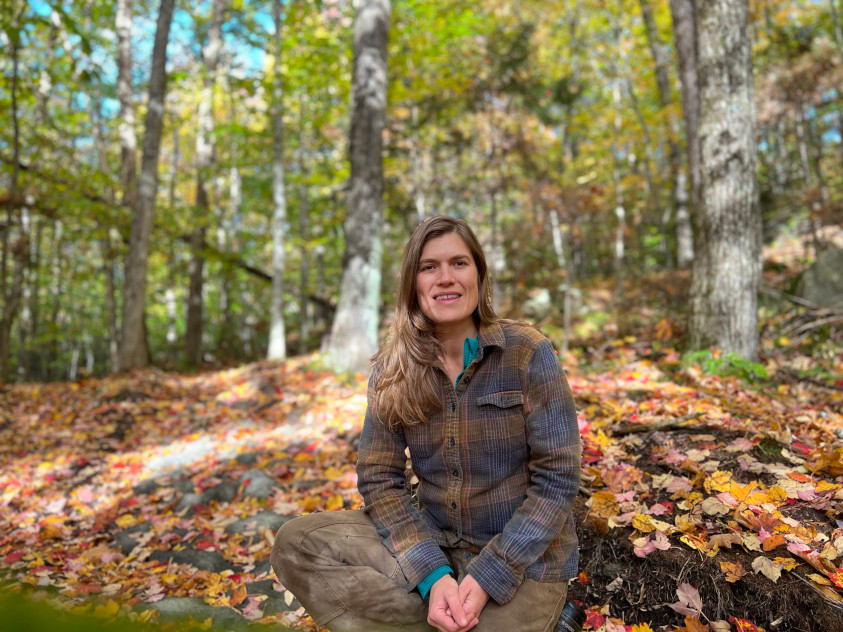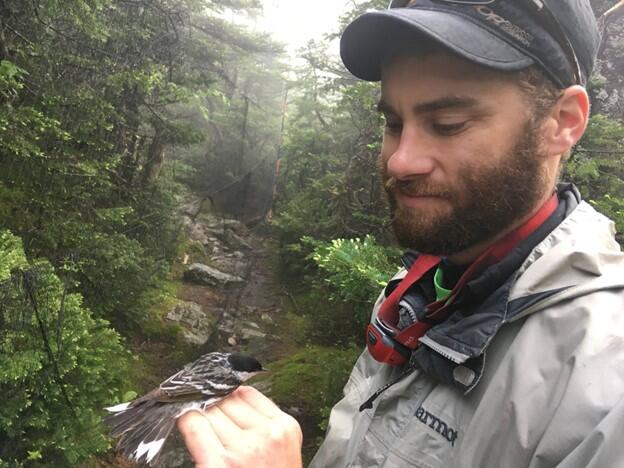Post-Meeting Content
FEMC has made available as much content from the meeting as possible. You can:
- Watch the opening remarks and invited speakers at the plenary session
- Read abstracts, download presentations, and view video from the contributed talks sessions, and
- View the posters presented at our poster session
A brief update on the Forest Ecosystem Monitoring Cooperative network, structure, services, and future.
VIDEOPlenary Session
Keynote Presentation
We are excited to announce the members of the panel who will share their expertise on how forests can serve as solutions to climate change, biodiversity, and well-being. We welcome Dr. Ali Kosiba, UVM Extension Assistant Professor of Forestry; Dr. Michelle Kondo, USFS Research Social Scientist; and Tim Duclos, Vermont Audubon Healthy Forest Program Associate. A panel discussion will be facilitated by the plenary Speaker, Heather Furman
Heather Furman, The Nature Conservancy
VIDEOContributed Talks
Four parallel tracks of 20-minute presentations contributed by cooperators on various forest ecosystem research, monitoring and outreach activities
Session 1
| Fire Adapted Forest Ecosystems Moderator: FEMC | Riparian Forest Management Moderator: FEMC | Winter Monitoring and Management Moderator: FEMC | Community and Citizen Science Moderator: FEMC |
|
|---|---|---|---|---|
Creating a model for fire management monitoring in dry oak habitats Ryan Rebozo ABSTRACT VIDEO PRESENTATION | 3 years of monitoring 15 riparian tree plantings on ANR land Sam Puddicombe ABSTRACT VIDEO PRESENTATION | New Hampshire Mountain Snow Monitoring Georgia Murray ABSTRACT VIDEO PRESENTATION | Community Science as a Tool for Understanding Mercury Contamination at Local and National Scales Celia Chen ABSTRACT VIDEO PRESENTATION | |
Creating a model for fire management monitoring in dry oak habitats Jay Kelly, Raritan Valley Community College Presenter: Ryan Rebozo, Vermont Center for Ecostudies The use of prescribed fire as a management strategy for achieving ecological goals in oak forests has gained interest from land managers as they attempt to address a variety of objectives including attempting to imitate past disturbance regimes, address invasive species, and promote regeneration of target tree species. Addressing changes in tree composition as a result of mesophication is often cited as a focus of management efforts in these habitats, yet these processes and confounding effects of herbivory and plant competition are not always well understood at the local level. Prescribed burning has been hypothesized to benefit the regeneration of oaks by reducing competition, duff depth, or seed predation and increasing light and nutrient availability. However, the benefits of fire for oaks and other hardwoods are highly variable, with the outcomes depending upon initial site conditions, species, timing, size class structure, and other factors, and may also be detrimental or counterproductive to achieving these goals. This project represented an opportunistic study to develop baseline monitoring data for two dry oak habitats as well as compare post-fire forest response to adjacent and satellite control sites. The goal of this project was to develop a rigorous monitoring protocol using FIA phase 3 methodology, infrared deer density surveys and a focus on rare species response in order to help inform the future use of prescribed fire for ecological purposes in this uncommon natural community. This monitoring effort identified a mixed response where the fire was effective at creating measurable changes in sapling mortality, and reducing leaf litter but unable to significantly consume the duff layer or stimulate the regeneration of oaks, both of which are stated goals for addressing mesophication. Local deer densities may already be impacting the regeneration of oaks beyond a lack of canopy gaps. Signs of spongy moth herbivory in the oak canopy and signs of beech bark and leaf disease throughout these forests suggest that much more light may be reaching the understory than densiometer-based measures of cover would suggest. The goal of stimulating oak regeneration through fire may be difficult to achieve in dry oak forests if deer herbivory and ambient deer densities are not taken into account and the resulting fire severity is unable to consume the existing duff layer. | ||||
3 years of monitoring 15 riparian tree plantings on ANR land Sam Puddicombe, VFWD Presenter: Sam Puddicombe, Vermont Fish and Wildlife Department Riparian restoration is as much an art as a science. To better inform the practice in Vermont, VFWD has spent the last three summers monitoring 81 plots in riparian tree plantings on 15 ANR owned parcels. Most plantings were not set up as experiments and sites varied in age of planting during the first year of monitoring (0-3 years post-planting), pre-planting conditions (retired ag, former athletic field, former berm, restored wetland, construction staging area), planting strategy (bareroot vs. live stakes, evenly spaced vs. clustered, professional vs. volunteer, planting density), and post-planting maintenance (competitor suppression, exclusion fencing). Natural tree regeneration was also monitored along with ground cover and species of and distance to potential source trees to evaluate passive restoration. Growth, survival, density and natural regeneration varied among sites and treatments, but many variables were confounded preventing robust analyses. Preliminary qualitative analyses lead us to believe pre-planting conditions had the biggest effect on survival and natural regeneration. Specifically, survival and natural regeneration were lowest in retired hay fields. Post-planting maintenance also affected survival of planted stems (sometimes negatively due to herbicide drift) but there was no clear effect on natural regeneration. Planting strategy seemed to have the least effect on survival and natural regeneration, and as a result the final stem density was correlated with the initial planting density. The results suggest altering pre-planting conditions of hay fields through site-preparation may be warranted. Passive restoration through natural tree regeneration may be possible at most types of sites other than hay fields, but natural regeneration is usually patchy and may not be apparent for 3 or more years of restoration. When the goal is to establish vegetated cover quickly, for example to curb infestation of exotic invasive plants, the liberal use of live stakes can be an economical alternative. | ||||
New Hampshire Mountain Snow Monitoring Maya Shyevitch, Appalachian Mountain Club Presenter: Georgia Murray, Appalachian Mountain Club There is clear evidence that the Northeastern U.S. snow season is shrinking, yet snow distribution in montane environments is complex with some areas able to retain snow longer. Therefore, the need for more distributed snow measurements is vital to understanding the ecological and economic impacts of changing winters. The Appalachian Mountain Club (AMC) operates the Pinkham Notch, New Hampshire National Weather Service COOP station with a 90+ year record of snowfall and snow depth. More recently, AMC began tracking daily snow depth at 4 backcountry huts and have estimated snow melt timing from a network of HOBO temperature loggers across the White Mountains, N.H. Expansion of a citizen-science effort called Community Snow Observations, where recreationists make snow depth measurements, is also filling in gaps across montane landscapes. Our study will combine AMC's data with other snow monitoring initiatives in the region to develop snow distribution and melt timing models, refining estimates as our spatial resolution improves. Results to date show Pinkham Notch, NH, at just over 600 meters elevation, has seen snowmelt occur 15 days earlier over a 92 year period. We compared snowmelt timing at forested plots, estimated by HOBO measurements of air temperatures, to daily human-observed snow stake measurements nearby, and found that the HOBO stations recorded earlier snowmelt than snow stakes. We attributed the difference to the height of the HOBO logger and premature melt from the HOBO radiation shield. High spatial variation in mountain environments and differences among methodologies point to a need for enhanced and harmonized snow data in Northeast montane areas. We will present on our continued evaluation using HOBO estimates and comparisons across our snow stake plots, as well as our roadmap for future snow analysis. We aim to develop snow distribution and snowmelt timing models to enable AMC's and partners' broader mountain monitoring efforts. | ||||
Community Science as a Tool for Understanding Mercury Contamination at Local and National Scales Celia Chen, Dartmouth College Presenter: Celia Chen, Dartmouth College Mercury (Hg) pollution is a persistent and prevalent threat to environmental health across the globe. In aquatic systems, inputs of inorganic Hg can transform into the more toxic and bioavailable organic form, methylmercury (MeHg). MeHg biomagnifies in aquatic food webs and can be transferred to terrestrial food webs. Mercury is of concern in northern New England due to relatively enhanced atmospheric inputs from long-range transport and legacy point-source pollution. The Dragonfly Mercury Project (DMP) is a nationwide study led by the National Park Service (NPS) and U.S. Geological Survey (USGS), in collaboration with Dartmouth College and the Appalachian Mountain Club (AMC). It has established a surveillance network for Hg in protected lands across the US by engaging community volunteers in the collection of dragonfly larvae as Hg biosentinels. The data generated through the DMP allowed for the creation of an integrated impairment index that informs wildlife and human health Hg risk based on dragonfly larvae Hg concentrations. In collaboration with the AMC, the Dartmouth DMP has been run for 13 years with schools in Vermont and New Hampshire and was expanded to include sites in White and Green Mountain National Forests and communities in Lawrence and Lowell Massachusetts. This talk will describe past and ongoing DMP programs run in collaboration with the Appalachian Mountain Club. These efforts provide spatial mercury data for New England states that are susceptible to hotspots of mercury bioaccumulation but lack consistent long-term monitoring. The utilization of community science efforts provides benefits of increased investment in and knowledge of local ecosystems as well as larger spatial and temporal patterns of Hg risk. | ||||
Regeneration dynamics in northeastern pitch pine barrens under different restoration scenarios Kathleen Stutzman ABSTRACT VIDEO PRESENTATION | Remnant old trees enhance large woody debris loading in low-order streams at the Hubbard Brook Experimental Forest Stephen Peters-Collaer ABSTRACT VIDEO PRESENTATION | Creating a Common Language for BC Ski Zone Management Kathryn Wrigley ABSTRACT VIDEO PRESENTATION | A real-time early detection and monitoring system based on citizen science observations Kyle Lima ABSTRACT VIDEO PRESENTATION | |
Regeneration dynamics in northeastern pitch pine barrens under different restoration scenarios Kathleen Stutzman, University of Vermont Presenter: Kathleen Stutzman, University of Vermont Fire suppression and disconnection from historic fire regimes has had a distinct and significant impact on fire-adapted natural communities, changing community structure, composition, and diversity, as well as fuel availability. The mesophication and densification associated with fire suppression in Eastern US forests has favored shade-tolerant and fire-sensitive species, creating new stable closed forest states, which will not easily revert to pre-suppression fire-adapted communities. Novel stressors facilitated by climate change have the potential to further degrade fire-adapted communities. For northeastern pitch pine barrens, fire suppression and the range expansion of Southern Pine Beetle (Dendroctonus frontalis) present substantial and imminent challenges to the restoration and maintenance of these rare, endemic communities. This study examines and evaluates the response of tree regeneration to a range of different restoration scenarios in pitch pine barrens across Maine, New Hampshire, Massachusetts, and New York. Restoration scenarios examined included thinning, spring prescribed fire, fall prescribed fire, and mowing followed by prescribed fire with monitoring also occurring in untreated areas. The overall goal of this work is to formulate region-wide best management practices to restore and maintain pitch pine barrens and to inform cultural and ecological objectives. For this talk, preliminary findings on the relationship between restoration scenarios and tree regeneration response will be discussed. | ||||
Remnant old trees enhance large woody debris loading in low-order streams at the Hubbard Brook Experimental Forest William Keeton, University of Vermont, USA Presenter: Stephen Peters-Collaer, University of Vermont, Rubenstein School of Environment and Natural Resources, and Gund Institute for Environment Secondary forests in New England are recovering from 19th century land-use along multiple pathways of development. Yet, it remains poorly understood how highly dynamic interactions between forests and streams will shift as stands develop late-successional/old-growth characteristics. Previous research has suggested that structural development in riparian forests will enhance important functions, including carbon storage and flood resilience, but sources of variation in riparian functionality remain poorly explored. This study investigated the effects of riparian forest structure, including indicators of late-successional development, on wood loading in low-order, headwater streams draining mature northern hardwood forests at the Hubbard Brook Experimental Forest (HBEF) in New Hampshire. We assessed in-stream large woody debris (LWD) along 300m longitudinal transects within 13 stream reaches using the line-intercept method (LIM) and a total wood census (TWC). We sampled in-stream habitat features, such as pools and debris dams, and measured attributes of riparian forest structure. We applied multi-hierarchical Bayesian models to investigate the effects of forest structure on LWD loading and the effects of LWD loading on pool- and debris dam frequency. Forest structure affected LWD loading, indicating strong effects of big tree density and dead tree density among other structural attributes. Debris dam frequency strongly depended on LWD frequency, while pool frequency depended more strongly on stream geomorphology. The LIM and the TWC sampling methods delivered significantly different results when comparing 50 m stream sections. Our findings highlight the importance of evaluation of adequate transect lengths for further applications of the LIM. We conclude that biological legacies like remnant old-growth trees, large secondary trees, and standing dead trees are important structural attributes promoting LWD in low-order streams. These effects translate into both enhanced in-stream carbon storage (the subject on on-going research) and greater aquatic habitat complexity. Practices that retain or restore large trees within riparian corridors are likely to yield similar benefits. | ||||
Creating a Common Language for BC Ski Zone Management Kathryn Wrigley, VT Dept. of Forests, Parks and Recreation Presenter: Kathryn Wrigley, VT Dept. of Forests, Parks and Recreation The Vermont Backcountry Ski Handbook was developed with input from the Vermont Department of Forests, Parks & Recreation, the Vermont Department of Fish & Wildlife, the US Forest Service, and the Catamount Trail Association. It covers natural resource and social considerations, building partnerships with public and private land managers, delineating backcountry ski zones, and outlines the process for implementation, construction, and maintenance of ski zones. It's a complete how-to guide for creating high quality, sustainable backcountry ski terrain in a cooperative fashion with forest land managers. By emphasizing a common language around ski zones, The Vermont Backcountry Ski Handbook will not only help land managers better administer their land for backcountry users, it will also help skiers and riders better understand and appreciate the concerns of land managers. This greater understanding between stakeholders should lead to stronger, more cooperative relationships. Come learn about this tool and the best management practices for backcountry ski zone implementation and management. | ||||
A real-time early detection and monitoring system based on citizen science observations Kyle Lima, Schoodic Institute at Acadia National Park Presenter: Kyle Lima, Schoodic Institute at Acadia National Park Climate change, invasive plants, and forest pests are rapidly changing forests in the northeastern United States. Detecting these changes early is critical to implementing cost-effective management and limiting the impact of disturbances. However, many forest disturbances likely go undetected until it is too late for cost-effective management because current monitoring protocols are labor intensive, focus on small monitoring plots, and require specialized skills. An early detection system that can be applied over large spatial scales is needed to help improve management. Schoodic Institute and Acadia National Park have attempted to fill this critical monitoring gap by developing an early warning system using tools in R that builds upon the large, and growing, number of citizen scientists already interacting with and visiting protected areas. We will present on the project that was built for Acadia National Park that consists of an auto-updating interface that summarizes reports of species park managers have identified as a monitoring priority (i.e., forest pests, invasive species, new species to the park, and threatened and endangered species). By working with citizen scientists in this capacity, we are able to keep monitoring costs low, engage the community in critical science, and detect species at a scale and rate likely not feasible otherwise. This project was built with customizability as a priority, and therefore the citizen science analysis workflow and interface are easily transferable to any protected area and the list of species can be specific to any manager's needs. | ||||
Session 2
| Old Forests, Land use, & Planning Moderator: FEMC | Forest Management and Restoration Moderator: FEMC | Climate Adaptation Moderator: FEMC | NSRC Track Moderator: NSRC |
|
|---|---|---|---|---|
Wildlands in New England: Past, Present, and Future--New Data and a Call to Action Elizabeth Thompson ABSTRACT VIDEO PRESENTATION | Vermont Seed Project Brooke Fleischman, Jess Colby ABSTRACT VIDEO PRESENTATION | Connected Forests for Climate Adaptation: Updates to Vermont Conservation Design Andy Wood ABSTRACT VIDEO PRESENTATION | NSRC Overview Aaron Weiskittel, Dan Dey ABSTRACT VIDEO PRESENTATION | |
Wildlands in New England: Past, Present, and Future--New Data and a Call to Action Elizabeth Thompson, WWF&C Presenter: Elizabeth Thompson, Wildlands, Woodlands, Farmlands, and Communities Wildlands In New England was published earlier this year by the Wildlands, Woodlands, Farmlands, and Communities (WWF&C) collaborative. The 112-page report offers a definition of WIldlands, a list of the values of WIldlands, abundant background on Wildlands concepts, and a report on the findings of the multi-year study that analyzed in detail over 400 potential Wildland properties throughout the region. The key finding is that the region is 80% forested but only 3.3% of the total land area is considered Wildland. To meet the goals of Vermont Conservation Design, the WWF&C vision, Vermont's new Biodiversity Bill, and the national and global 30x30 goals, much more needs to be done. Many partners provided access to legal documents, management plans, and other agreements, formal and informal, to allow us to calculate the amount of wildland in the region. Each property submitted was scrutinized to determine if it met the criteria laid out. The data are assembled in an online database which is updated regularly based on submissions from partners. I will describe the report and its findings, will demonstrate the online portal, and will describe the process and criteria for submission of new data. Finally, I will offer some illustrated examples of recently protected Wildlands. | ||||
Vermont Seed Project Jess Colby, NorthWoods Stewardship Center Presenter: Brooke Fleischman, Jess Colby, Intervale Conservation Nursery, NorthWoods Stewardship Center Vermont Seed Project Brooke Fleischman, State Seed Coordinator, Intervale Center (Virtual) Jessica Colby, Riparian Lands Coordinator, NorthWoods Stewardship Center (In Person) While there is increasing demand for locally adapted native plant materials for riparian restoration projects, nurseries are unable to adequately ramp up supply to accommodate those needs. Between 2015 and 2020, work was completed by Annalise Carrington (formerly of the Intervale Center), Pete Emerson (Vermont Fish & Wildlife Department), and Fritz Gerhardt (Connecticut River Conservancy) to look at different techniques for site preparation at riparian restoration sites. The goal was to control the existing vegetation to (a) expose enough bare soil to allow for successful natural regeneration of riparian woody species and/or (b) prepare a seedbed to allow for the direct seeding of riparian woody species. Some of their main challenges were identifying seed collection locations and gathering enough seed to use in these trials. In 2021, the Vermont Seed Project (VSP) started as a collaborative effort amongst Vermont Fish & Wildlife (VFWD), Intervale Center, NorthWoods Stewardship Center (NWSC), U.S. Fish and Wildlife Service (USFWS), The Nature Conservancy (TNC), and many others to begin collections of native tree and shrub species. In 2023, the VSP hired a statewide seed coordinator to better coordinate partners to gather, process, store, and use 22 species of native riparian shrub and tree seeds across the state for restoration purposes. The VSP works closely with local conservation nurseries on native plant propagation and with other partners on forest restoration projects. The partnership continues their efforts with direct seeding trials alongside Vermont Fish & Wildlife as an alternative restoration approach to planting bare-root stock. We work to build out capacity by acquiring seed cleaning machines, expanding storage space, and housing a database of mapped seed source locations and phenology data. Looking to the future, the Vermont Seed Project expects to understand the demand, ramp up supply, and create more coordinated and collaborative efforts across the northeast region toward local native seed. The VSP pilot program has received support (3 years) from the VFWD and USFWS and is expected to conclude in 2025. Our presentation will review our work-to-date, outline our plans for next season and beyond, and discuss challenges and opportunities for this work into the future. | ||||
Connected Forests for Climate Adaptation: Updates to Vermont Conservation Design Robert Zaino, VT Fish & Wildlife Department Presenter: Andy Wood, VT Fish & Wildlife Department For the last two years, the Vermont Fish & Wildlife Department and partner organizations have been working to update the Habitat Blocks Dataset, an integral building block for Vermont Conservation Design. Vermont Conservation Design is a scientific vision identifying the highest priority lands and waters needed to sustain Vermont's biodiversity into the future. Using the University of Vermont's high-resolution LiDAR-derived landcover datasets together with other data products has allowed us to re-map all Habitat Blocks statewide, now including the many connecting lands along the margins of Habitat Blocks that stitch together the network of connected forestland across the state. Join us for a preview of this work and a discussion on how these connecting lands serve our climate adaptation aspirations. | ||||
NSRC Overview Presenter: Aaron Weiskittel, Dan Dey, UMaine, USFS Aaron Weiskittel, University of Maine NSRC director, and Daniel Dey, USFS, will present on the current and future outlook for the Northern States Research Cooperative, a competitive grant program for Northern forest research supporting cross-disciplinary, collaborative research in the Northern Forest. The current RFP will result in nearly $5 million in 2024 for research that addresses the importance of the Northern Forest to society and the need to work collaboratively with the people who live within its boundaries, work with its resources, use its products, visit it, and care about it. | ||||
The Status of Current and Future Old Forests in Vermont Robert Zaino ABSTRACT VIDEO PRESENTATION | Open Forest Ecosystems of Southern New England: Their Characteristics, Restoration, and Importance to Biodiversity Tom Wansleben ABSTRACT VIDEO PRESENTATION | Using Habitat Restorations to Test Climate Change Adaptation Strategies Chris Nadeau ABSTRACT VIDEO PRESENTATION | Implementing forest adaptation options for Northern Forest ecosystems Tony D'Amato ABSTRACT VIDEO PRESENTATION | |
The Status of Current and Future Old Forests in Vermont Robert Zaino, Vermont Fish and Wildlife Department Presenter: Robert Zaino, Vermont Fish and Wildlife Department The conservation and restoration of old forests are important parts of many large-scale conservation plans, including Vermont Conservation Design, and the Wildlands, Woodlands, Farmlands & Communities initiative. While old forests have been often studied in Vermont, there is still a lack of comprehensive data on the extent and condition of existing old forests, so the Vermont Fish and Wildlife Department's Natural Heritage Inventory has begun to map and track old forest natural communities. I'll summarize the data we've collected so far, and our inventory efforts to identify previously unknown old forest examples. I'll also present results of an analysis of expected future old forests (forests of any age now that are likely to develop into old forests under natural processes), and how their spatial distribution and natural community types contribute to meeting the old forest targets in Vermont Conservation Design. | ||||
Open Forest Ecosystems of Southern New England: Their Characteristics, Restoration, and Importance to Biodiversity Tom Wansleben, MassWildlife Presenter: Tom Wansleben, Massachusetts Division of Fisheries and Wildlife Open Forest ecosystems of oak & pine woodlands and savannas once covered significant areas of interior southern New England for millennia. Shaped and tended by Indigenous fire practices, these park-like ecosystems with their large but spaced overstory trees and little to no mid story, promoted a rich understory of diverse sun loving vegetation including forbs, grasses, and shrubs that in turn supported an abundance of biodiversity. The decimation of Indigenous societies followed by fire suppression policies, have led to the dramatic loss of these pyrogenic ecosystems all over the East, resulting in monumental vegetation shifts to denser multi layered forests composed of more shade tolerant mesophytic species like red maple. This loss, especially of the understory vegetation is thought to be a significant factor in the decline of the biodiversity they once supported including many specialized plants and their pollinating insect counterparts. In Massachusetts alone approximately 40% of plant and animal species listed under the Massachusetts Endangered Species Act directly benefit from fire influenced open forest ecosystems along with numerous other declining species making their restoration a conservation priority. To address this priority, the Massachusetts Division of Fisheries and Wildlife (MassWildlife) has invested in the acquisition and landscape scale restoration of lands that once supported these open forest habitats including the development of a robust prescribed fire program. But before fire can be applied, the restoration of these sites often requires commercial timber harvests, mulching and herbicide applications along with a complex web of permitting. But the ecological results are often rapid and dramatic, including the return of state listed birds after decades of absence, tripling of bee species diversity and endangered plant populations going from a few individuals to some of the largest population in the state. What wasn't anticipated but celebrated is the re-connection of people to these open forest ecosystems through foraging, hunting and birding. This talk will provide an overview of the characteristics of these open forests including where they are found on the landscape, how they are actively being restored, the positive response of biodiversity (including humans) to these efforts and the immense opportunities for much needed regional research on these forgotten ecosystems. | ||||
Using Habitat Restorations to Test Climate Change Adaptation Strategies Randall Hughes, Northeastern University Presenter: Chris Nadeau, Schoodic Institute at Acadia National Park Dozens of climate change adaptation strategies have been proposed in the literature, and practitioners are already implementing many of these strategies worldwide. However, very few strategies have been tested empirically to determine if and when they will be effective. Hence, conservation agencies could be investing significant resources in strategies that fail to produce the desired results or cause harmful unintended consequences. Rigorous tests of climate change adaptations strategies are necessary to support conservation under climate change. In this presentation we will suggest that rigorous tests of climate change adaptation strategies are likely lacking because of a tradeoff between the time and resources necessary to implement these tests, and the urgent need for action. We will highlight limitations with current recommendations that call for implementing a single action, monitoring for effectiveness, and adapting management practices as necessary. We will then suggest an alternative approach where management actions are designed as experiments to test climate change adaptation strategies without delaying action. Specifically, we will suggest that practitioners employ multiple climate change adaptation strategies simultaneously following the tenets of experimental design, including: replication, randomization, and control treatments. Using this experimental approach will not only provide the evidence necessary to improve future management, it also has many other benefits, including: (1) increasing resilience of the managed system through the portfolio effect, (2) providing tests of our knowledge in climate change biology, (3) helping practitioners and funders overcome the fear of failure by learning from failed actions, (4) resolving stakeholder conflicts, and (5) providing opportunities for highly effective science and management communication. We will conclude by providing two case studies to demonstrate the benefits of taking an experimental approach to test climate change adaptation strategies during ecological restorations: (1) a test of assisted gene flow on mountain summits and (2) a test of multiple methods to slow the spread of invasive species in wetlands. | ||||
Implementing forest adaptation options for Northern Forest ecosystems Presenter: Tony D'Amato, University of Vermont Climate change and increasing prevalence of non-native invasive insects and diseases are some of the most significant challenges facing forest managers in sustaining ecosystems across the Northern Forest region. This project will increase the application of adaptation strategies to enhance forest resilience to climate change and invasive pest and disease impacts, while also sustaining critical ecosystem services, including wildlife habitat, carbon storage, and local forest-based economies. NSRC researchers will evaluate outcomes and effectiveness of already implemented adaptation strategies and partner with resource managers to produce site-tailored recommendations on best practices for anticipated impacts of climate change and invasive species. This project uses a network of adaptation experiments and demonstrations in Maine, New Hampshire, New York, and Vermont on more than 30 sites to better understand the ability of forest adaptation strategies to address emerging forest health and climate change impacts. Researchers will measure forest structural, compositional, and functional outcomes of these strategies at these sites to document forest management approaches that provide the greatest adaptation potential for northern hardwood, mixedwood, and spruce-fir ecosystems. Through partnerships with federal, state, Tribal, private, and NGO forestry stakeholders, researchers will develop outreach materials, such as pamphlets, webpages, webinars, and workshops that identify sitetailored, best adaptation practices for these key forest types in northern New England and New York. | ||||
Tracking Parcelization and Land Use Change in Forests to Inform Policy and Planning Jamey Fidel ABSTRACT VIDEO PRESENTATION | Planting 2 Billion Trees in support of Climate Change Mitigation, Biodiversity, and Human Well-being Sevrenne Sheppard ABSTRACT VIDEO PRESENTATION | Climate-friendly forest management on AMC's Maine Woods Initiative David Publicover ABSTRACT VIDEO PRESENTATION | Assisted Migration: A Viable Silvicultural Technique for Facilitating Adaptation of Northern Forest Tree Species to a Warmer and Drier Future World? Matt Vadeboncouer ABSTRACT VIDEO PRESENTATION | |
Tracking Parcelization and Land Use Change in Forests to Inform Policy and Planning Jamey Fidel, Vermont Natural Resources Council Presenter: Jamey Fidel, Vermont Natural Resources Council Forests play a critical role in maintaining biodiversity, ecosystem integrity, and serving as a natural solution to climate change, but land use trends demonstrate we are fragmenting and converting forests due to development and land use change. In order to maintain the resiliency and integrity of forests, it is necessary to understand where parcelization and land is subdivision is occurring, and the rate at which it is occurring. This FEMC funded project responded to this need by building a database to examine trends on private land in Vermont by using Grand List (property tax) land classification and Use Value Appraisal Program data from 2005 to 2020. In addition, this project created a Parcelization Website to examine trends at the town, county, regional planning commission, and state level to inform housing, conservation, land use policy. The presentation will provide an overview of land use and parcelization trends in the state, with particular attention to trends demonstrating the increasing loss of large, undeveloped woodland parcels. In addition, the presentation will share the results of a case study utilizing Property Transfer Tax Return data to perform GIS spatial analysis of subdivisions in forests. Recommendations for maintaining the integrity forests through land use and state policy will be provided. | ||||
Planting 2 Billion Trees in support of Climate Change Mitigation, Biodiversity, and Human Well-being Sevrenne Sheppard, Canadian Forest Service Presenter: Sevrenne Sheppard, Policy Analyst, Canadian Forest Service In 2021, the Government of Canada launched the 2 Billion Trees Program (2BT), which aims to motivate and support new tree planting projects across the country. Over a period of 10 years, by 2031, up to $3.2 billion will be invested in tree planting efforts to support provinces, territories, third-party organizations (for-profit and not-for profit) and Indigenous organizations to plant two billion trees across Canada. Projects funded by 2BT will contribute to Canada's GHG emission reduction and net zero emissions targets. 2BT also aims to achieve several co-benefits, including long-term restoration and maintenance of forests for species at risk and other species of interest, increasing forest diversity and climate resilience, and enhancing the well-being of Canadians for generations to come. Over the past two years, 2BT has been working to develop an approach to measuring the impacts of funded projects on biodiversity and human well-being. This presentation will give an overview of the program's progress and lessons-learned in the first two years of planting, and will discuss plans for measuring biodiversity and well-being outcomes. | ||||
Climate-friendly forest management on AMC's Maine Woods Initiative David Publicover, Appalachian Mountain Club Presenter: David Publicover, Appalachian Mountain Club The Appalachian Mountain Club's Maine Woods Initiative is the most ambitious undertaking in the Club's 150-year history. Begun in the early 2000s as an effort to integrate land protection, backcountry recreation, biodiversity conservation, sustainable forestry, and community partnerships, MWI now encompasses about 114,000 contiguous acres in the 100-Mile Wilderness region of Maine, nearly all of which is encumbered by multiple conservation easements. Through a combination of reserves and conservative timber management, AMC is working to restore these heavily harvested former industrial lands to a more natural, mature, and structurally complex forest with higher value for biodiversity, carbon storage, and climate resilience. Currently about 28% of the ownership is in permanent ecological reserves, another 14% is other no-harvest protection zones, and 4% is nonforested, leaving 54% available for timber management. AMC's management is certified by the Forest Stewardship Council as part of The Nature Conservancy's group certificate, and our conservative approach has been compensated through three verified carbon offset projects. The presentation will discuss AMC's forest management and silvicultural approach, how we are incorporating "climate-friendly" practices into our management, how 2010 and 2020 inventories show significant early progress towards our goal of restoring a more mature forest, the extensive research and monitoring activities taking place across the property, and how the proceeds from carbon offset projects are being reinvested in support of AMC's "Net Zero by 2050" organizational goal. | ||||
Assisted Migration: A Viable Silvicultural Technique for Facilitating Adaptation of Northern Forest Tree Species to a Warmer and Drier Future World? Presenter: Matt Vadeboncouer, UNH Greater frequency and intensity of drought in the Northern Forest region will likely impact survival, growth, and reproduction of different tree species under future climate conditions. At the same time, the rate at which climate is changing in the region is outpacing tree species' ability to migrate into future suitable habitats. Both of these phenomena threaten sustainability of the region’s forest ecosystems and communities. Forestry assisted migration, the intentional movement of climate-adapted tree species into anticipated future suitable areas outside their current range, may be a useful silvicultural tool for promoting future resilient forests. NSRC researchers and local stakeholders in the four-state region will evaluate the capacity of ten assisted migration tree species to acclimate to new environments and drought in a periodically drier, warmer future Northern Forest. They will also quantify how morphological, anatomical, and physiological tree species traits show plasticity, or flexibility, to handle drought and the potential for particular traits to be indicators of seedling success. The research builds on an existing project, Adaptive Silviculture for Climate Change (ASCC), which initiated an assisted migration experiment across a network of seven sites throughout the Northern Forest. At the main study site, Second College Grant in New Hampshire, researchers will conduct a drought experiment to assess seedling acclimation potential and trait plasticity. Measurements will be collected at the other six ASCC sites to evaluate seedling responses across broader temperature and precipitation gradients at the landscape scale. The results will inform guidelines for selecting suitable assisted migration species as part of climate change adaptation strategies to promote future resilient forests. | ||||
Vermont Town Forest Census Julie Frost ABSTRACT VIDEO PRESENTATION | Tree regeneration and carbon replacement in forests of the northern US Lucas B. Harris ABSTRACT VIDEO PRESENTATION | Evaluating the Efficacy of Audubon’s Bird-friendly Maple: Can Managing Sugarbushes for Birds Provide Additional Benefits to Biodiversity, Ecosystem Services, and Forest Resilience? Steve Faccio ABSTRACT VIDEO PRESENTATION | ||
Vermont Town Forest Census Cecilia Danks , UVM RSENR Presenter: Julie Frost , University of Vermont RSENR Town forests play a special role in forest conservation in the Northern Forest region because they are publicly managed and accessible forest parcels that contribute to forest integrity, ecosystem services and community well-being. They also serve as effective models to family forest owners of how to conduct sustainable forest management to achieve diverse conservation goals. Acquisition of new town forests often adds strategic pieces to regional conservation efforts that counteract the growing fragmentation of the Northern Forest and help sustain the forest products industry. Many communities, however, find that managing these parcels can also bring special challenges as they seek to provide diverse public demands with limited resources. For these reasons and more, town forests are identified in the Vermont Forest Action Plan as a priority landscape, and several public and private initiatives in recent years have sought to build the capacity of communities to meet such challenges. Project collaborators have identified several needs hampering these efforts: the lack of a complete inventory and key contacts of town forests, inadequate public maps and information on town forests, and uneven knowledge of community needs. The VT Town Forest Census will help fill these gaps by conducting a complete census of forests owned by VT municipalities which can be repeated periodically in the future. We will identify fixed parameters to monitor in every census, as well as novel questions that address emerging issues and capture innovation. Identifying the needs and progress of municipalities in addressing diversity, equity, and inclusion in their town forests are among the topic priority issues for this census. We will ask towns about their interest, actions and capacity-building needs regarding disabled access, incorporation of cultural history, contributions to health and economy, and meaningful land acknowledgements and accompanying actions. Additionally, we will be using the InVEST Software (The Natural Capitol Project, Stanford University) to assess the benefits of several ecosystem services. As a work in progress, this presentation will share challenges and learning to date while seeking input from attendees on what resources we should share with local communities as we reach out to them to conduct this census, as well as the highest priority questions to ask. To have good response rates, we will strive to have a short survey and will invest the time and resources to reach all communities. | ||||
Tree regeneration and carbon replacement in forests of the northern US Christopher Woodall, USDA Forest Service Research and Development, Forest Inventory and Analysis Presenter: Lucas B. Harris, University of Vermont Natural regeneration in forests across the US is threatened by a confluence of factors including climate change, heavy browsing, changes to disturbance regimes and non-native pests and pathogens. Tree regeneration patterns shape forest carbon dynamics by determining the composition of future forests, which suggests that threats to natural regeneration may diminish the capacity of forests to replace carbon lost through tree mortality. Yet, the potential implications of tree regeneration patterns for future carbon dynamics have been sparsely studied. We used field plots from the Forest Inventory and Analysis (FIA) program to investigate how the composition of existing tree regeneration may influence future carbon storage for forests across the northeastern and midwestern US, leveraging a recently-developed method to predict the likelihood of sapling recruitment from seedling abundance within the six seedling height classes monitored under FIA's detailed Regeneration Indicator protocols. A model of live aboveground tree carbon storage was developed and used to compare predicted carbon storage based on seedling composition to predictions based on existing tree composition. Plots predicted to lose carbon storage based on seedling composition tended to be on steeper and south-facing slopes, be located farther east, have higher current carbon storage and be within maple/beech birch and oak/hickory forest types. Our results demonstrate the need to consider tree regeneration through the lens of carbon replacement in order to develop effective management strategies to secure long-term carbon storage. | ||||
Evaluating the Efficacy of Audubon’s Bird-friendly Maple: Can Managing Sugarbushes for Birds Provide Additional Benefits to Biodiversity, Ecosystem Services, and Forest Resilience? Presenter: Steve Faccio, VT Center for Ecostudies Maple sugaring is experiencing rapid growth across the Northern Forest in the scale of operations, acreage impacted, and number of people involved. As a result, it is becoming increasingly important to better understand how sugarbushes can be managed to benefit both maple production and biodiversity conservation. Maple syrup can be produced from forests that are managed in dramatically different ways. The long-term sustainability of maple sap production is entirely contingent on healthy forests, but our knowledge is limited on how the complex drivers of increased maple sap production intensity, differing management strategies, and climate change will affect biodiversity, ecosystem services, and overall ecological health of sugarbushes. By conducting field surveys of biodiversity and ecosystem service metrics across a gradient of sugarbush production and management intensities, NSRC researchers will pioneer this knowledge base and develop tools and policies that provide sustainable sugarbush management guidelines that are relevant across the Northern Forest landscape. This will result in updated guidance for sugarmakers and specific revisions to the bird-friendly maple management guidelines in order to achieve the desired benefit for bird populations. | ||||
Working Groups
Thanks to the many cooperators that took the time to connect and expand collaborative networks and ideas. Summaries of the outcomes of these sessions will be published in the 2023 Conference Proceedings in early 2023
Alpine ecosystems in the Northern Forest region are relatively rare, but have outstanding ecological significance, high biological diversity, and provide important recreational opportunities for millions of users. Unfortunately, most alpine ecosystems in the region are highly degraded due to both human trampling and vulnerability to climate change. Protecting, restoring, and increasing the climate resilience of these unique ecosystems requires a better understanding of the management priorities and research needs among diverse stakeholders. However, we currently lack a comprehensive, evidence-based management toolbox for alpine ecosystems in the Northern Forest to guide management. The Appalachian Mountain Club (AMC), Schoodic Institute, and White Mountain National Forest propose a workshop geared toward co-producing an alpine management toolbox. We seek to engage an audience of stakeholders currently active in alpine stewardship, such as members from the Northeastern Alpine Stewardship Meeting group, the Natural Areas & Mountain Environmental Science (NAMES) Research Initiative, and the FEMC, as well as state and federal agencies and experts on alpine vegetation. We will identify existing management strategies and challenges during a facilitated discussion and roundtable. A key outcome of this workshop will be to identify the type of 'toolbox' product that would be most useful to managers and gather examples of similar adaptation and management tools that have been useful in their work. We will follow up in individual interviews with resource managers who have implemented montane vegetation management strategies to refine our understanding of the key characteristics of successful actions and roadblocks to critical challenges. An evidence-based management toolbox would help ensure that managers are implementing the most effective tools and that the resources we are investing in management today will continue to provide benefits in the future as climates change.
Organizer: Jordon Tourville, Appalachian Mountain Club
The uncertainty around the impacts of climate change, invasive species, and extreme weather events poses a significant challenge to sustaining forest ecosystems in the northeast. In response to this challenge, numerous field applications and experiments have been developed over the past decade that are testing different adaptation strategies to maintain diverse forest values in the face of changing environmental conditions. This working group session will present a forthcoming managers guide based on the outcomes of this work and broader manager input that outlines best adaptation practices for northern hardwood, mixedwood, and spruce-fir forests. The session will facilitate discussion among forestry professionals, adaptation specialists, and research scientists to improve the final version of the guide and garner input on adaptation strategies being used by the broader management community to address climate change impacts to these key ecosystems. The outcomes of this session will inform the design of a manager's field guide to adaptation and associated web resources highlighting adaptation case studies to enhance the region's capacity for implementing and sharing the outcomes of forest adaptation in practice.
Organizer: Tony D'Amato, University of Vermont
This session will share information about the Northeast Snow Study (NESS) and a newly funded effort to create a mountain observatory network in the northeast. The session will seek feedback from participants in the development of these networks.<br /> <br /> NESS is a collaborative effort between the Natural Resource Conservation Service (NRCS), the University of New Hampshire, the University of Vermont, the Schoodic Institute in Maine, and the Appalachian Mountain Club to develop a feasibility study for a regional snow monitoring network in the Northeast.<br /> <br /> The UVM Summit to Shore Cold Weather Environmental Observation Network, funded by the Cold Regions Research and Engineering Laboratory, has 22 snow and weather monitoring stations spanning from Lake Champlain to the Northeast Kingdom. A new $500,000 EPA Environmental Network grant will fund the development of a shared web portal between this network, the Mount Washington Observatory's regional mesonet in New Hampshire, and the Atmospheric Sciences Research Center's mountain weather observation network on Whiteface Mountain in New York.
Organizer: Joshua Benes, University of Vermont
The FEMC community has expressed interest in exploring patterns of tree mortality and how regional coordination of monitoring for both acute events and delayed responses following chronic stress can lead to a better understanding of regional impacts. Landowners and residents may observe an acute tree mortality event or note trees experiencing other stress because of environmental conditions. However, there is not always a clear process to report observations and share information with experts or other community members. This working session will be used to form a network map of individuals and organizations who will serve as first responders to disturbances. First responders will act as a point of contact for landowners and residents to report observations. The network of first responders will serve as a community of practice for experts to share information with each other, implement action plans, and prepare recommendations for landowners. The network will be composed of people from across the region with expertise in a variety of disturbance types including pests and pathogens and physical disturbances. This working session will also explore preferred methods for communicating with a network and identify opportunities for ongoing engagement.
Organizer: Elissa Schuett, University of Vermont
Back to Top
Some presenters have made their posters available for download.
Not Available
Alpine plants as a model system for understanding biodiversity dynamics in a warming world: Integrating genetic, functional, and community approaches
Jacquelyn Gill, University of Maine
Caitlin McDonough-MacKenzie, Bennington College
Jose Meireles, University of Maine
isaac Overcast, California Academy of Sciences
Andrew Rominger, University of Hawaii
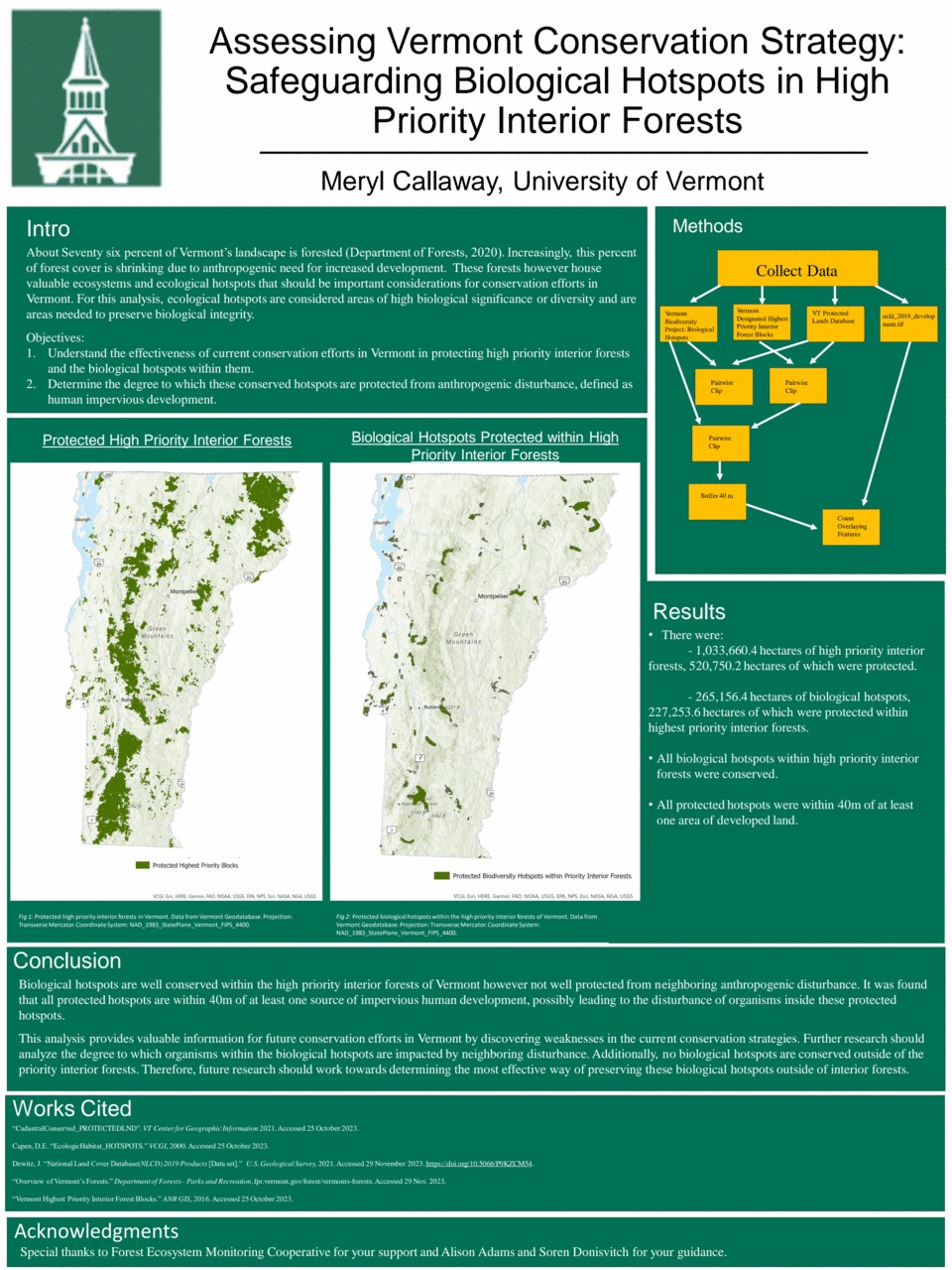
Assessing Vermont's Conservation Strategy: Safeguarding Biological Hotspots in High-Priority Interior Forests
Meryl Callaway, University of Vermont
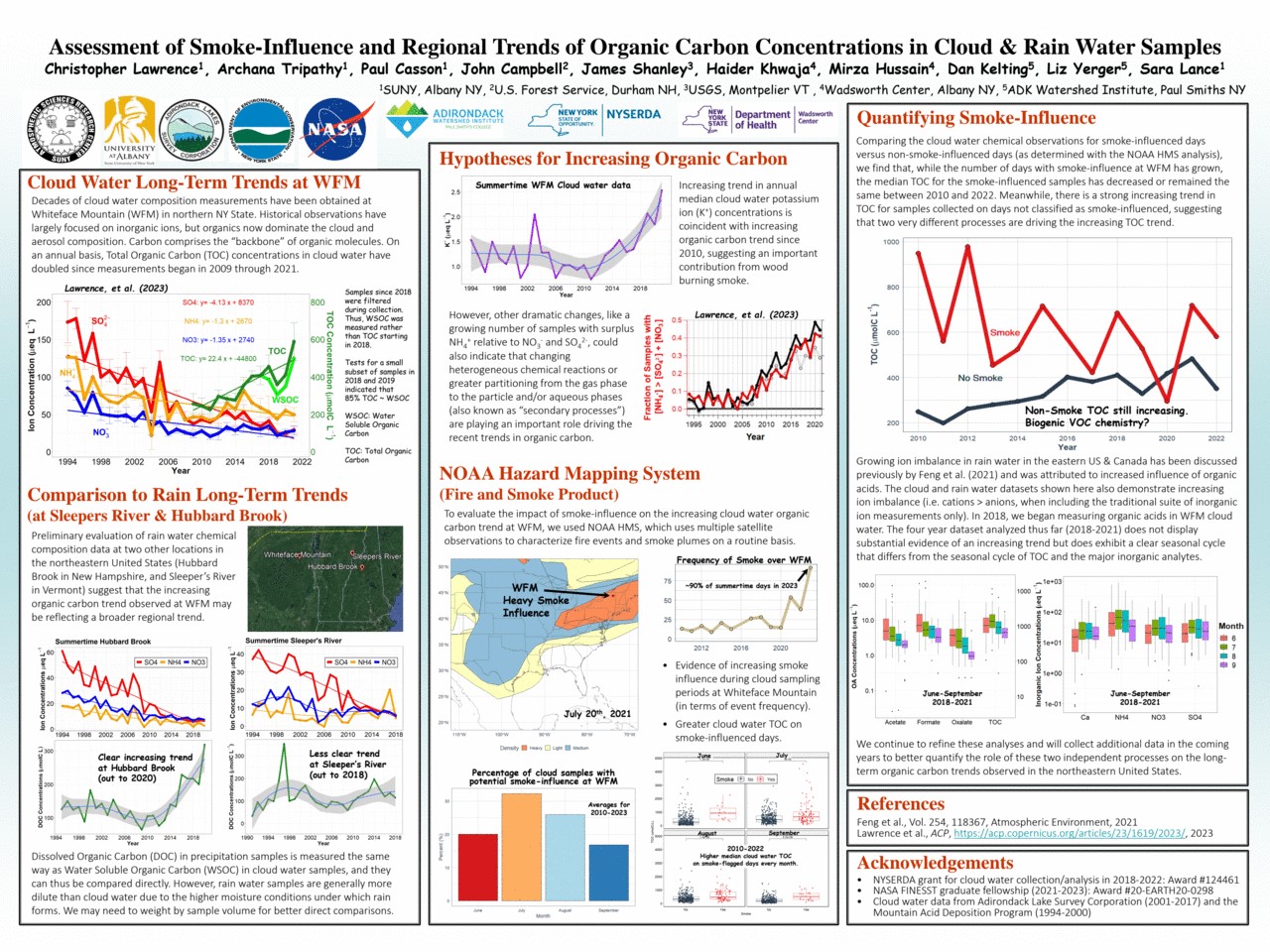
Assessment of Smoke-Influence and Regional Trends of Organic Carbon Concentrations in Cloud & Rain Water Samples
Christopher Lawrence, Archana Tripathy, Paul Casson, John Campbell, James Shanley, Haider Khwaja, Mirza Hussain, Dan Kelting, Liz Yerger, Sara Lance
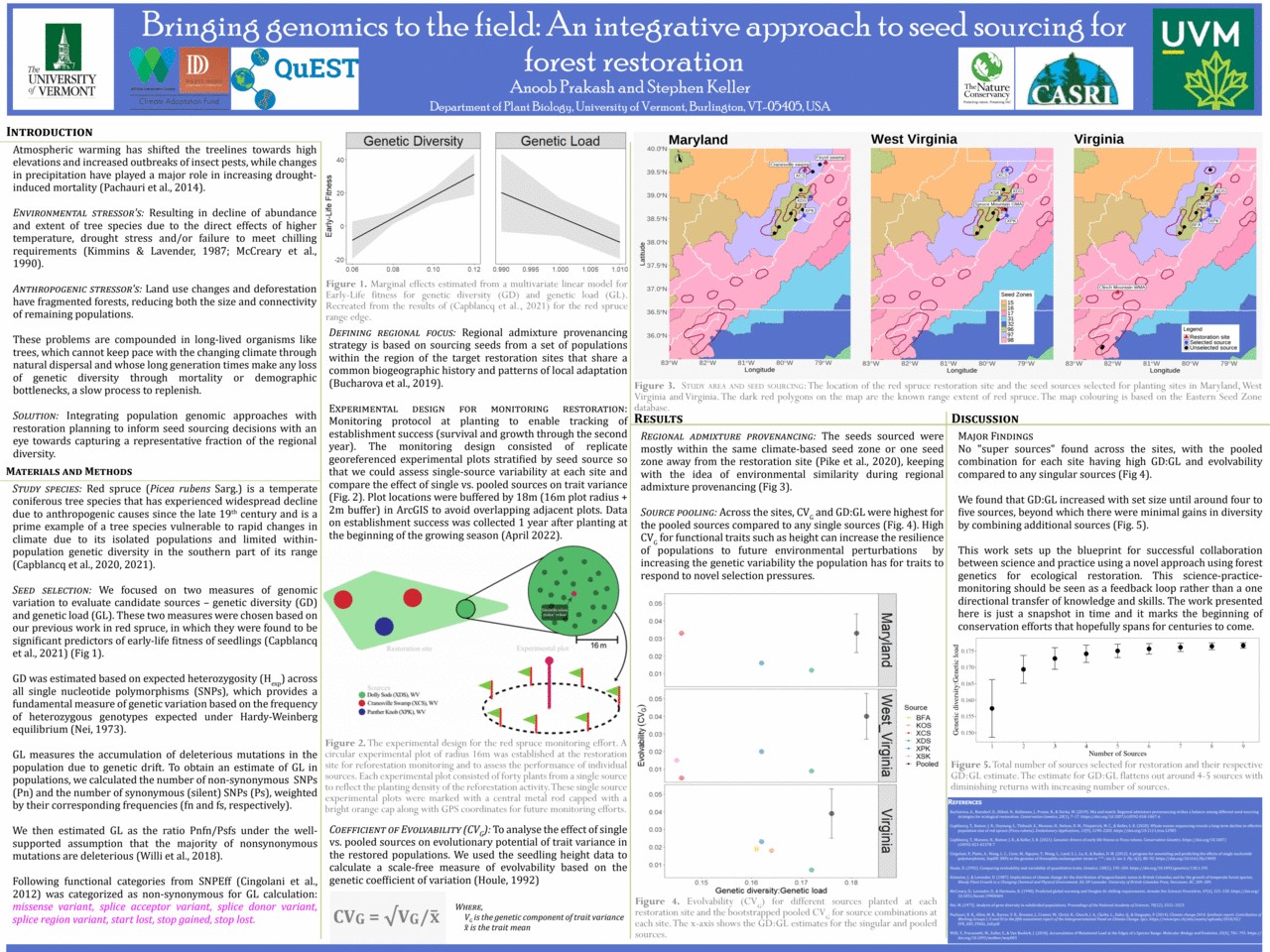
Bringing genomics to the field: an integrative approach to forest restoration
Anoob Prakash, Department of Plant Biology, University of Vermont
Stephen Keller, Department of Plant Biology, University of Vermont
Not Available
Carbon dioxide removal by managing forests under natural disturbances in the Northeastern U.S.
Mark Ashton, Yale University
Mark Ducey, University of New Hampshire
Mark Bradford, Yale University
Sara Kuebbing, Yale University
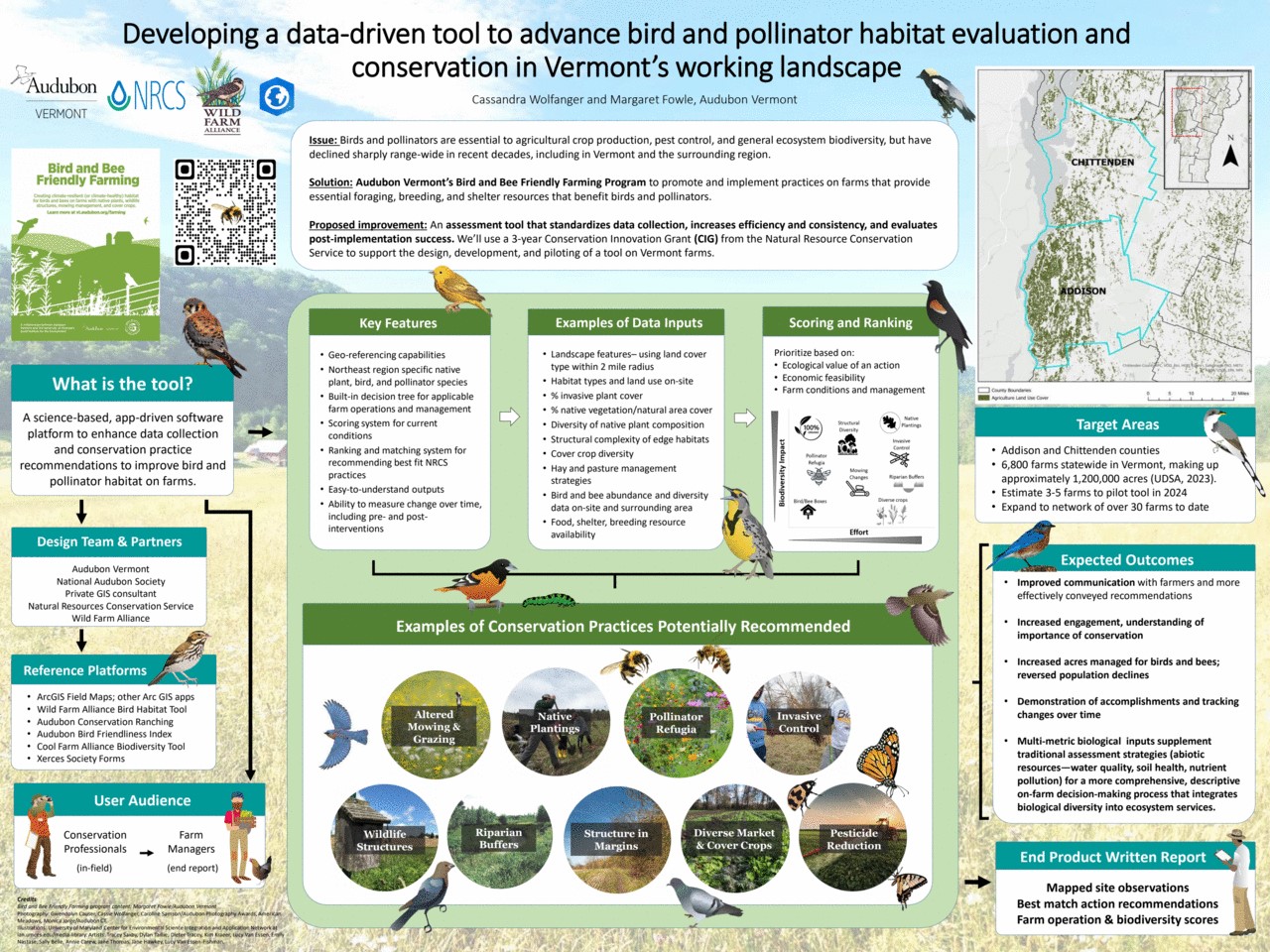
Developing a data-driven tool to advance bird and pollinator habitat evaluation and conservation in Vermont's working landscape
Cassandra Wolfanger, Audubon Vermont
Margaret Fowle, Audubon Vermont
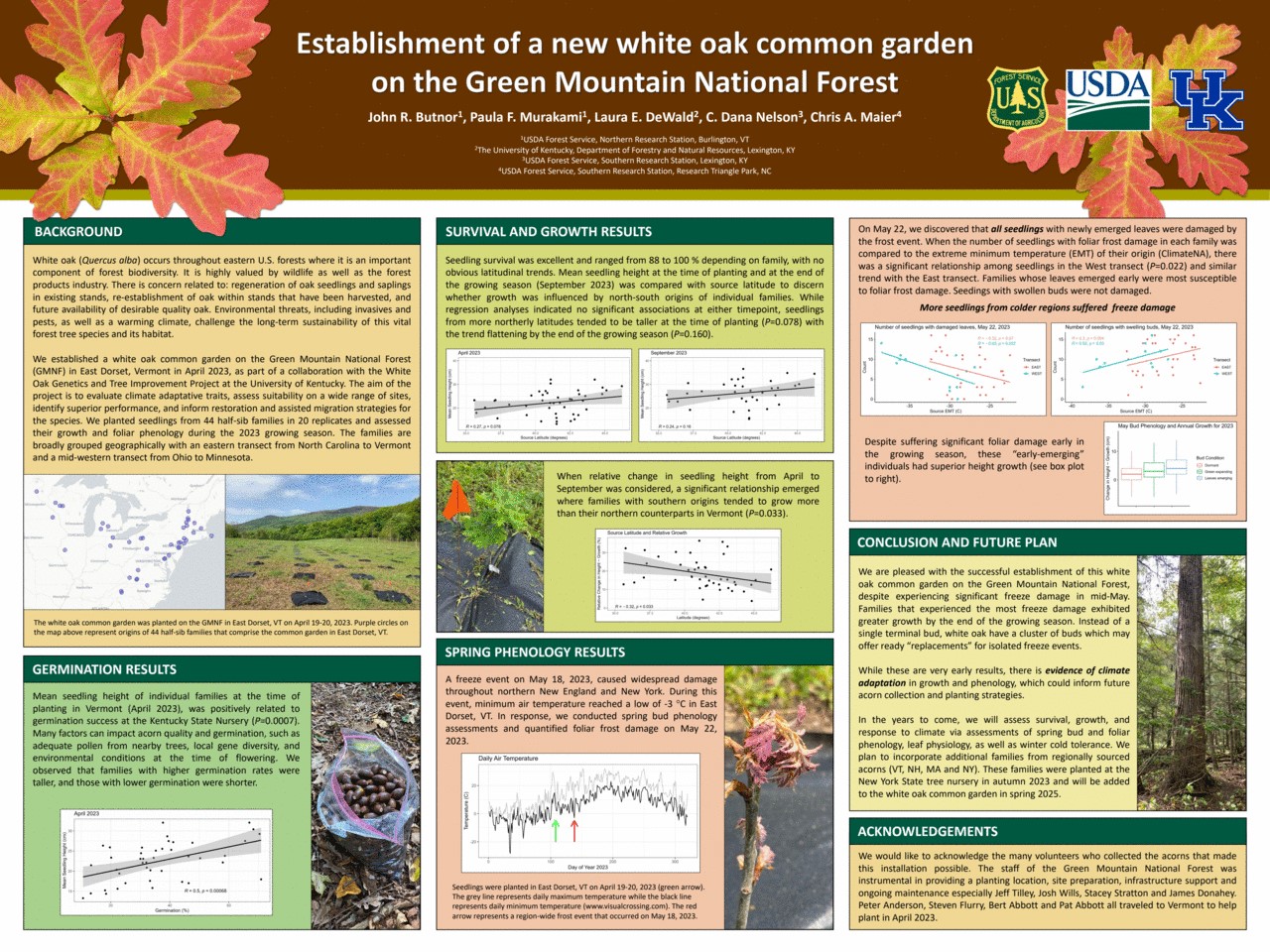
Establishment of a new white oak common garden on the Green Mountain National Forest
Paula Murakami, USDA Forest Service, Northern Research Station
Laura DeWald, University of Kentucky
Dana Nelson, USDA Forest Service, Southern Research Station
Chris Maier, USDA Forest Service, Southern Research Station
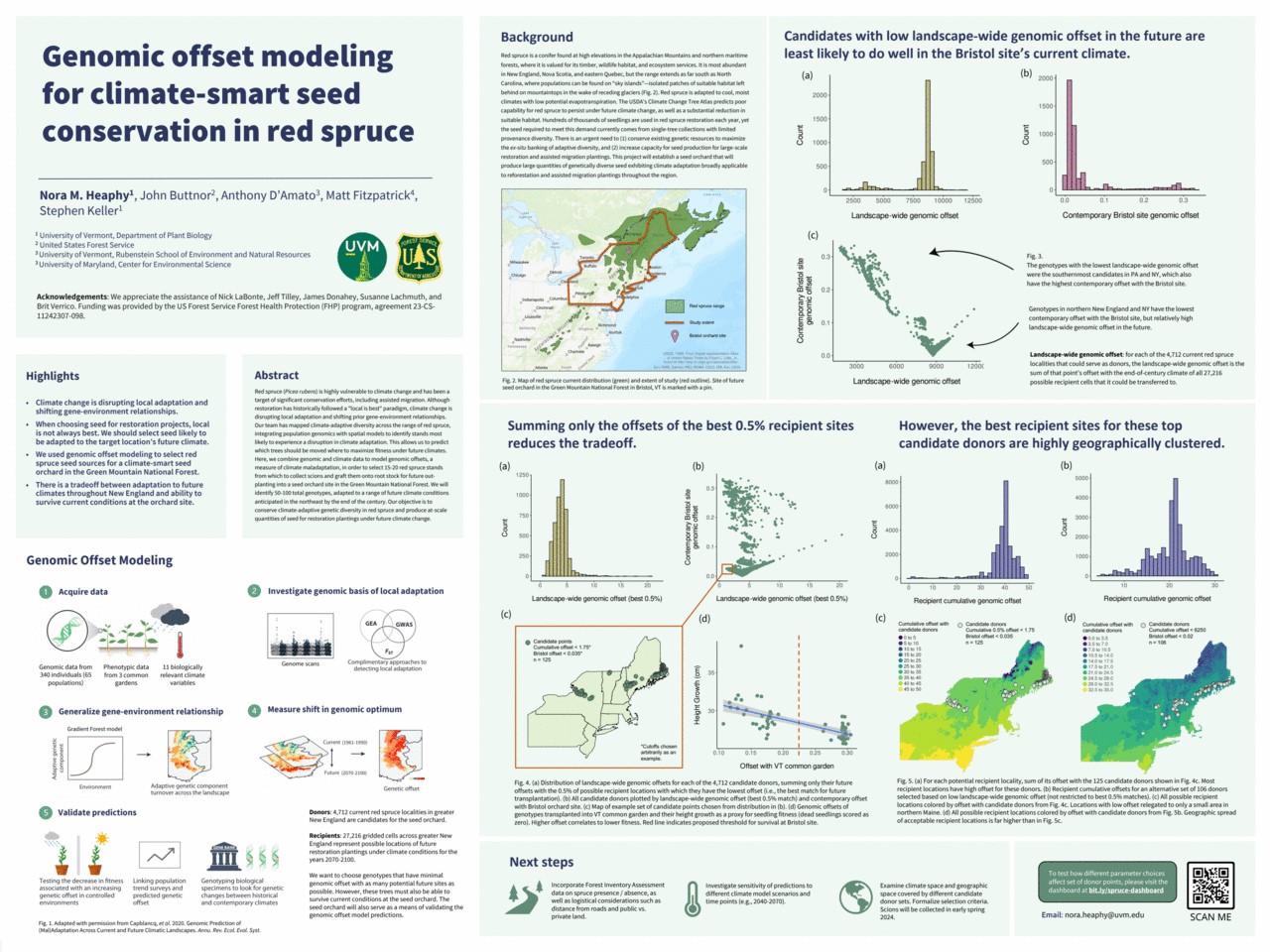
Genomic offset modeling for climate-smart seed conservation in red spruce
Anthony D'Amato, University of Vermont
Matt Fitzpatrick, University of Maryland
John Buttnor, US Forest Service
Stephen Keller, University of Vermont
Not Available
Incorporating tree genetic variation into forest monitoring: Spatial genetic analysis of Northern Red Oak (Quercus rubra) from a study site in southern Maine USA.
Steven Travis, University of New England
Sienna Matregrano, University of New England
Greg Zogg, University of New England
Not Available
Northeast Silviculture Library
Tony D'Amato, University of Vermont
Jill Levine, University of Vermont
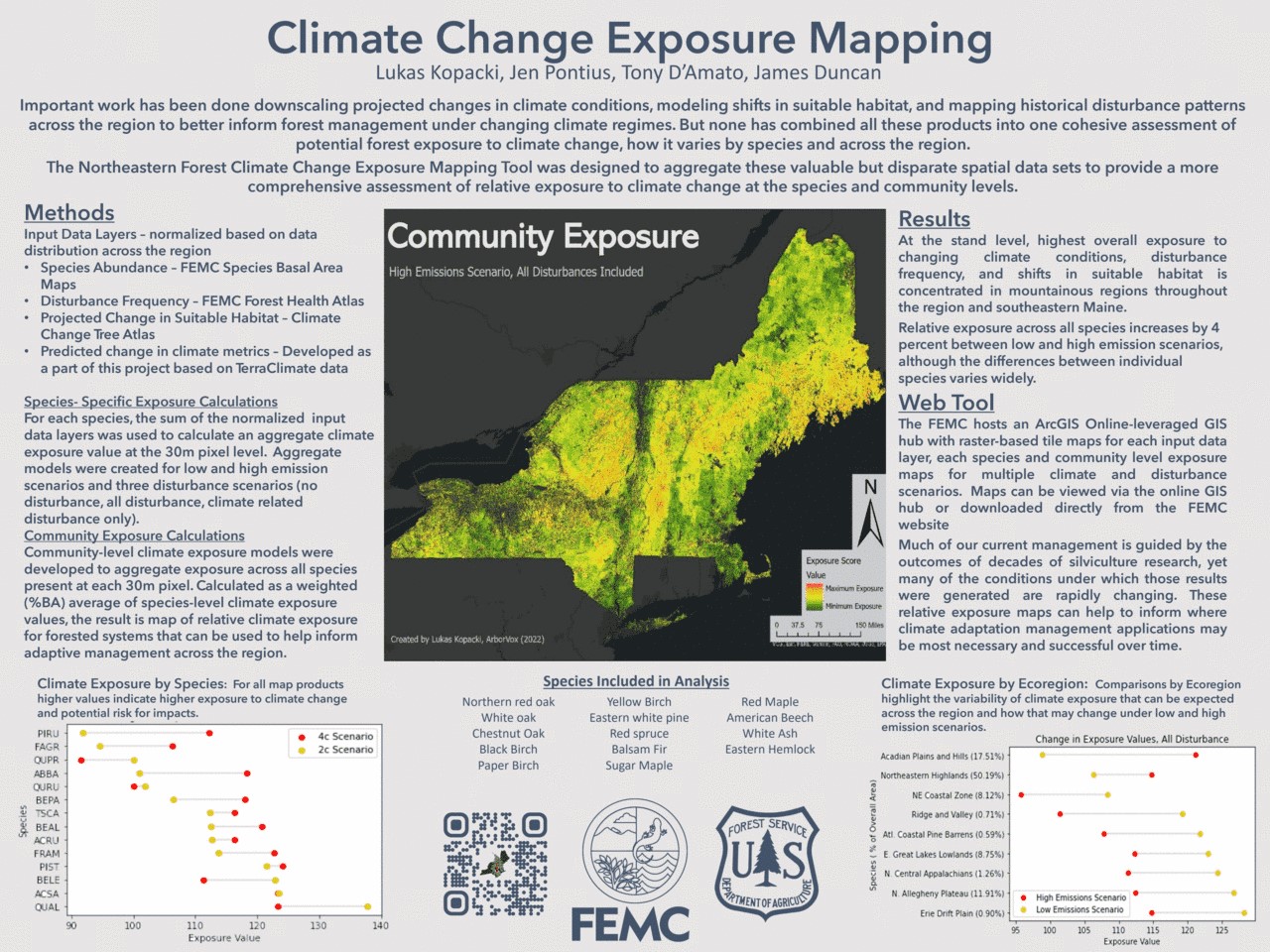
Northeastern Forest Climate Change Exposure Mapping
Lukas Kopacki, FEMC, ArborVox
Jen Pontius, FEMC, UVM
Tony D'Amato, UVM
Jim Duncan, VT DNR
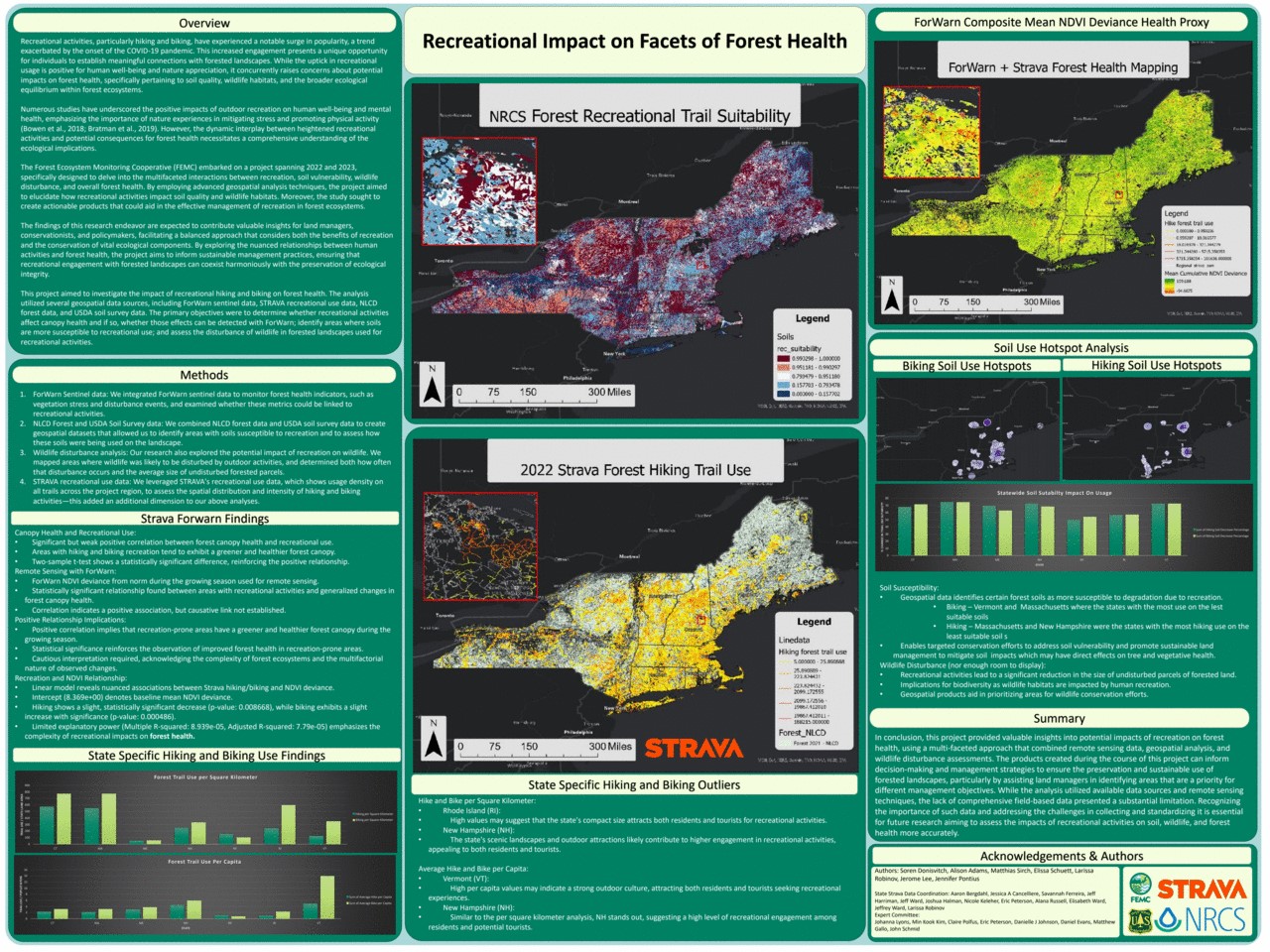
Recreational Impact on Facets of Forest Health
Soren Donisvitch, Alison Adams, Matthias Sirch, Elissa Schuett, Larissa Robinov, Jerome Lee, Jennifer Pontius
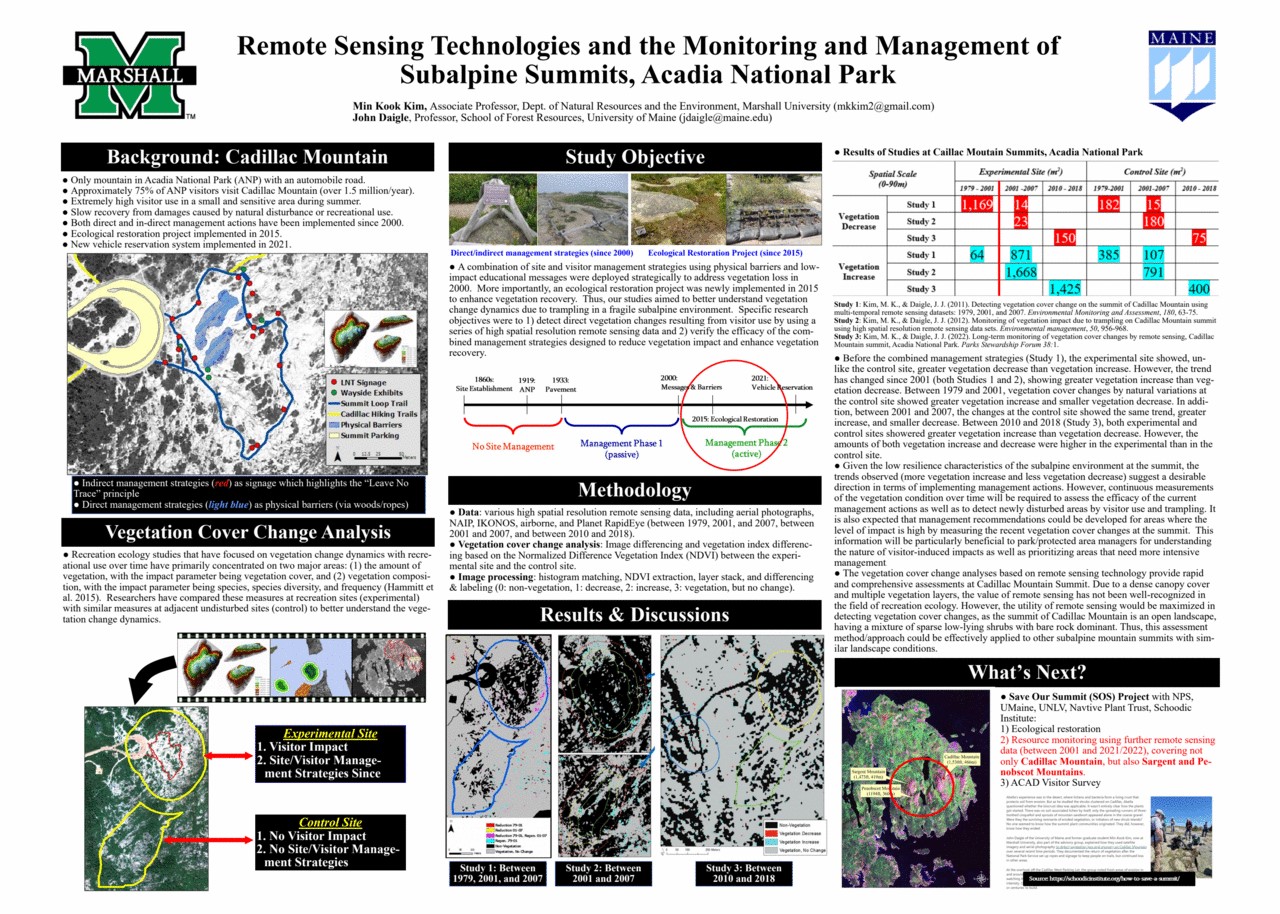
Remote Sensing Technologies and the Monitoring and Management of Subalpine Summits, Acadia National Park
John Daigle, University of Maine
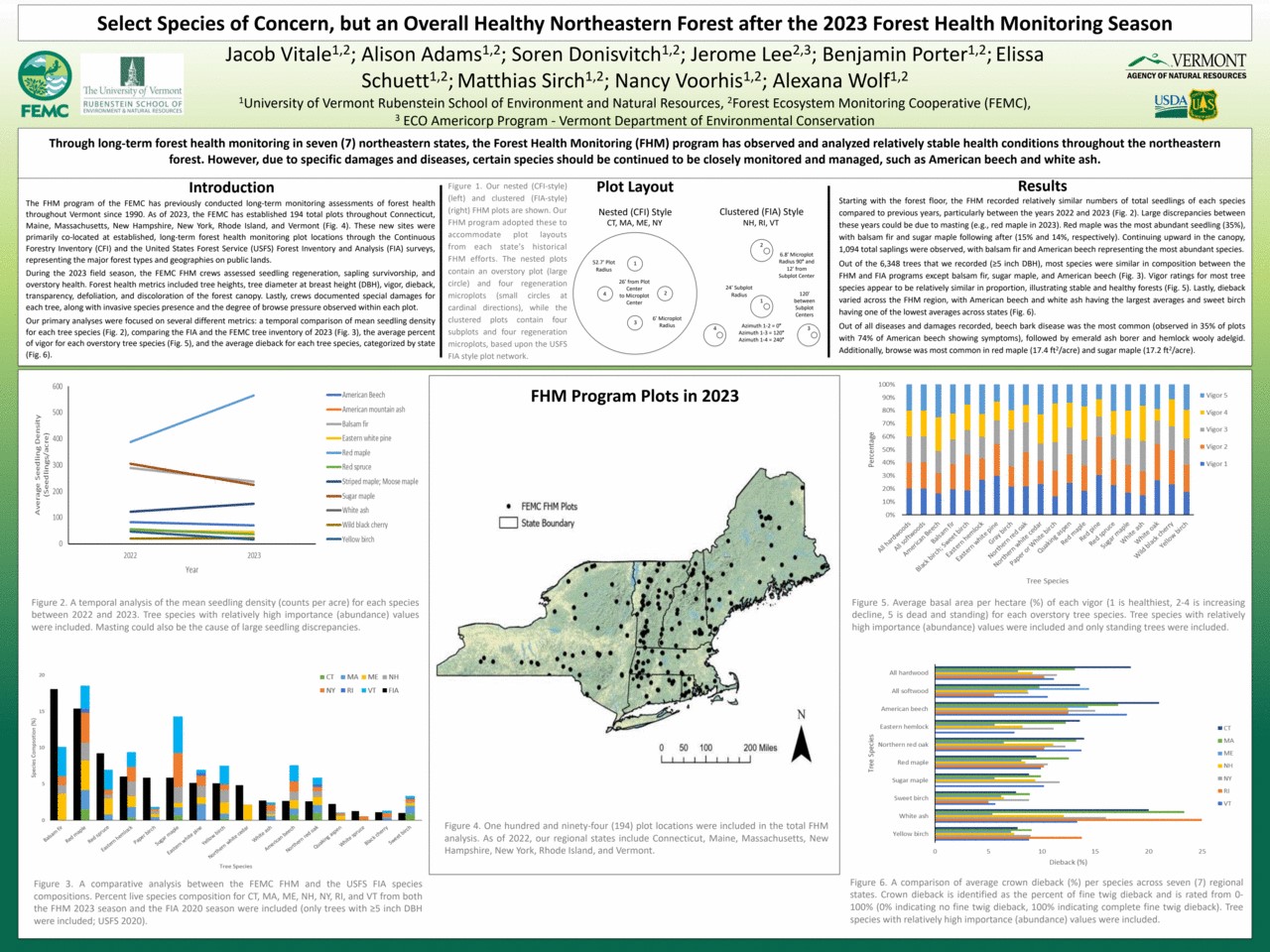
Select Species of Concern, but an Overall Healthy Northeastern Forest after the 2023 Forest Health Monitoring Season
Jacob Vitale, Alison Adams, Soren Donisvitch, Jerome Lee, Benjamin Porter, Elissa Schuett, Matthias Sirch, Nancy Voorhis, and Alexana Wolf
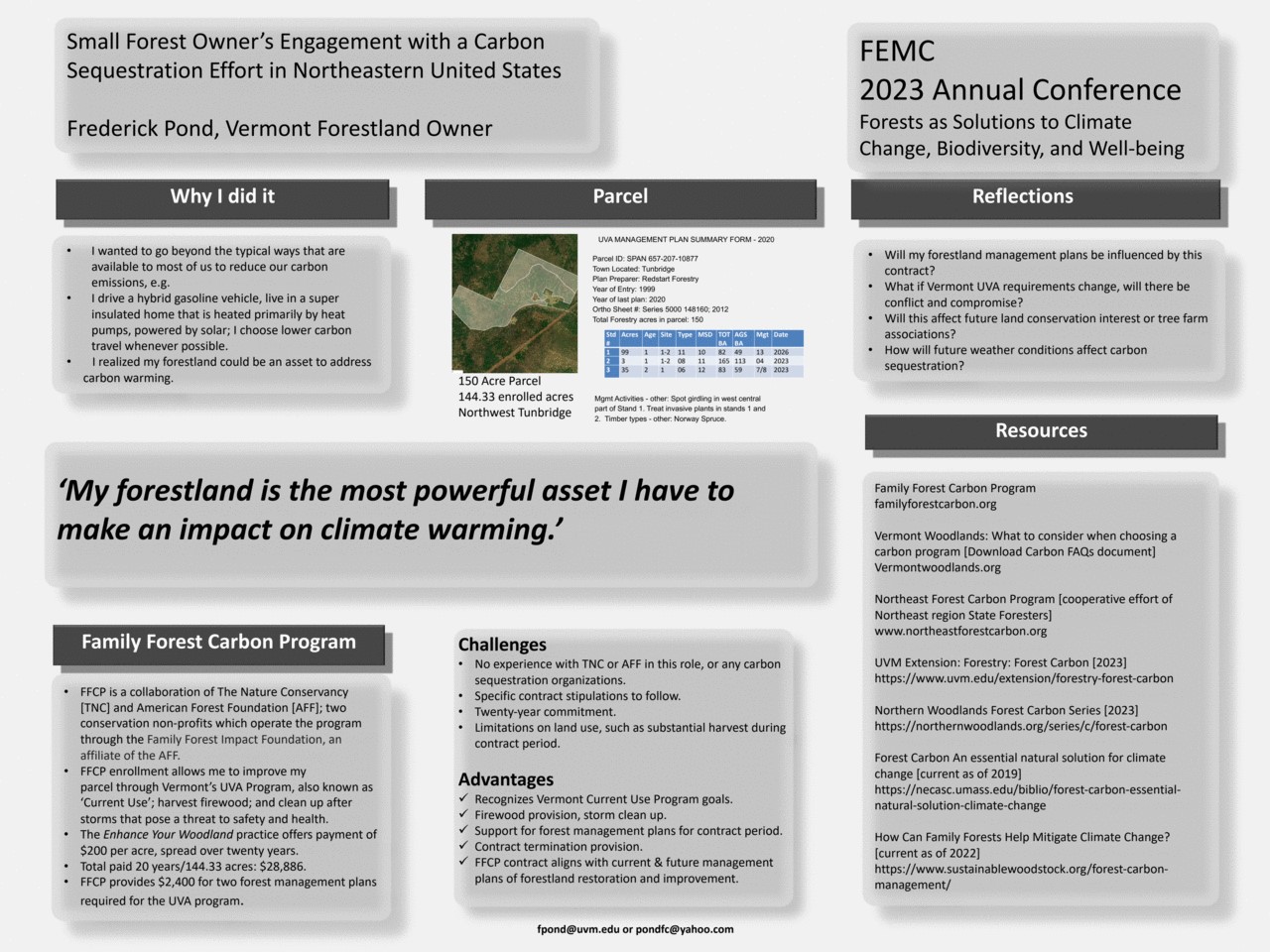
Small Forest Owner's Engagement with a Carbon Sequestration Effort in Northeastern U.S.
Frederick Pond, Vermont Forestland Owner
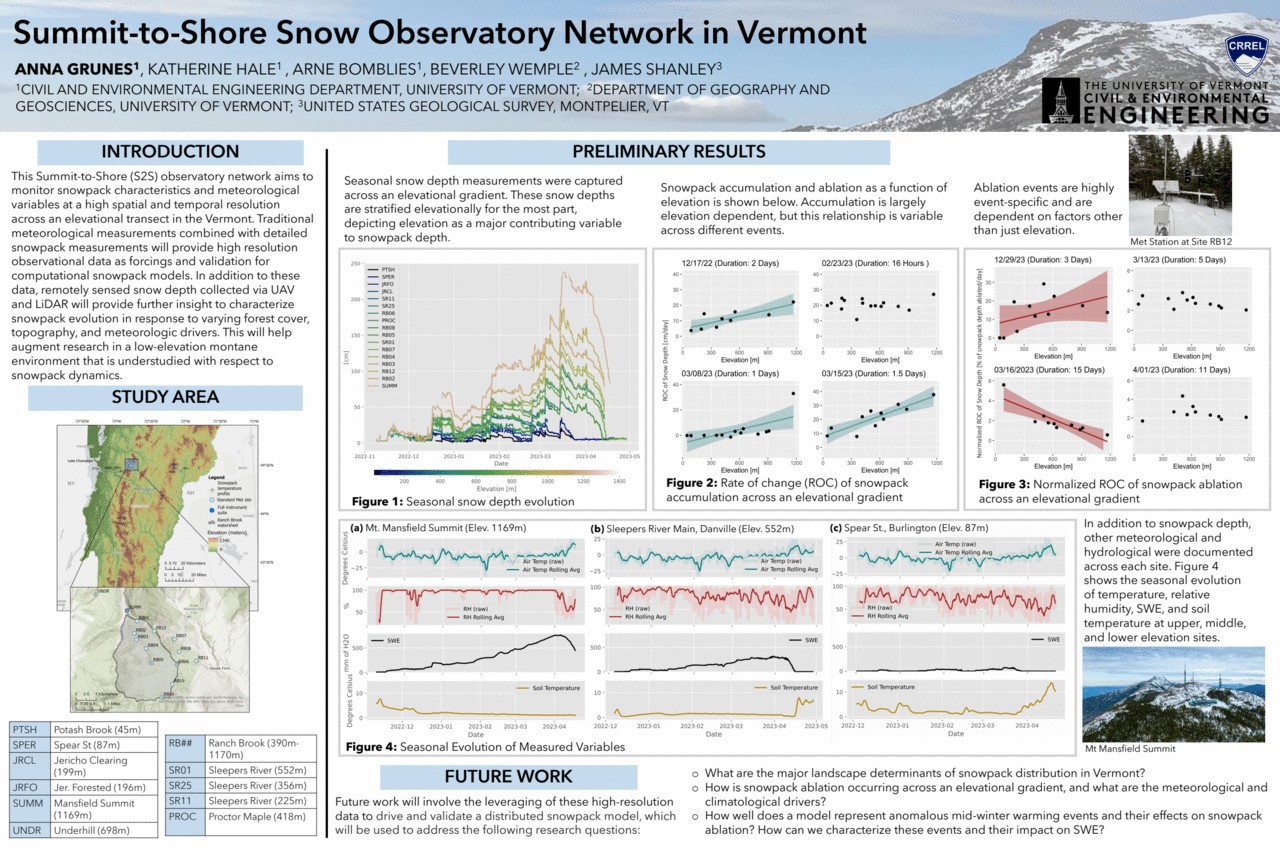
Summit-to-Shore Snow Observatory Network in Vermont
Katherine Hale, University of Vermont
Arne Bomblies, University of Vermont
Beverley Wemple, University of Vermont
Jamie Shanley, US Geological Survey
Not Available
test poster
Alexana Wolf, UVM
Not Available
The Cotton Brook landslide: Effects on water quality and macroinvertebrate community health
Aaron Moore, State of Vermont
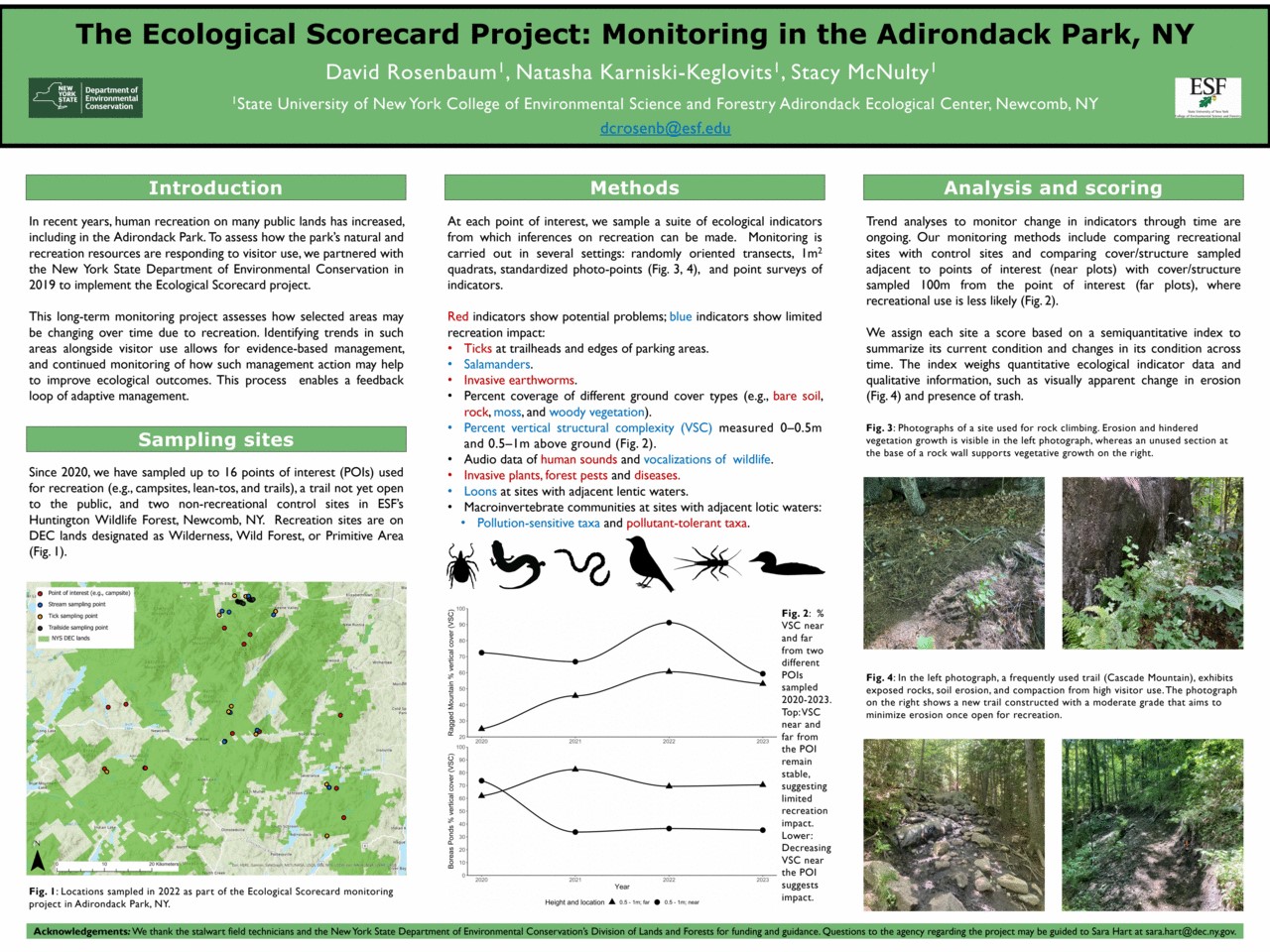
The Ecological Scorecard Project: Monitoring ecological indicators in the Adirondack Park, NY
Natasha Karniski-Keglovits, SUNY ESF Adirondack Ecological Center
Stacy McNulty, SUNY ESF Adirondack Ecological Center
Not Available
Thermal Calendars to Inform Management in a Changing Climate
Theresa Crimmins, USA Nantional Phenology Network
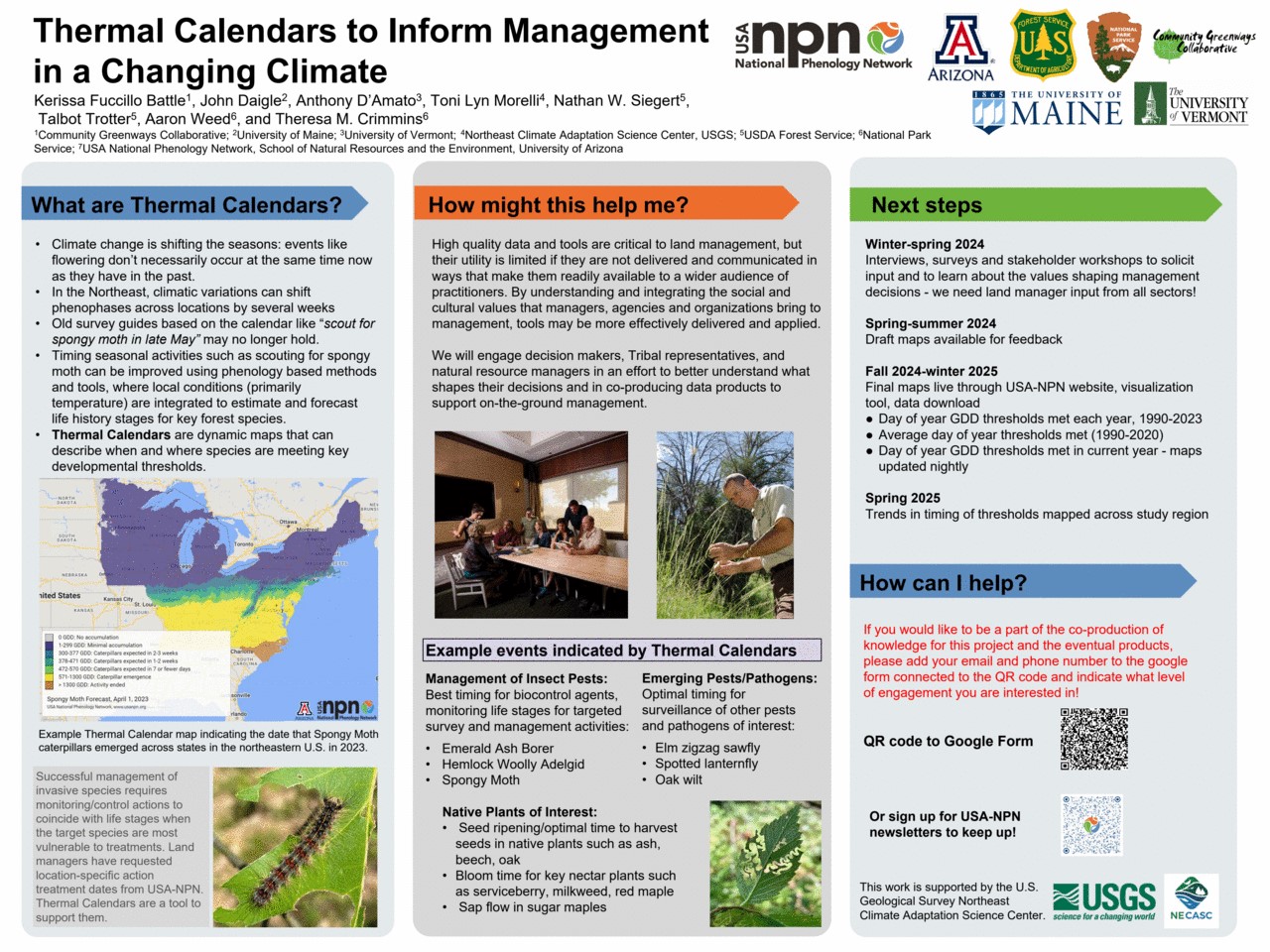
Thermal Calendars to Inform Management in a Changing Climate
Kerissa Fuccillo Battle, Aaron Weed
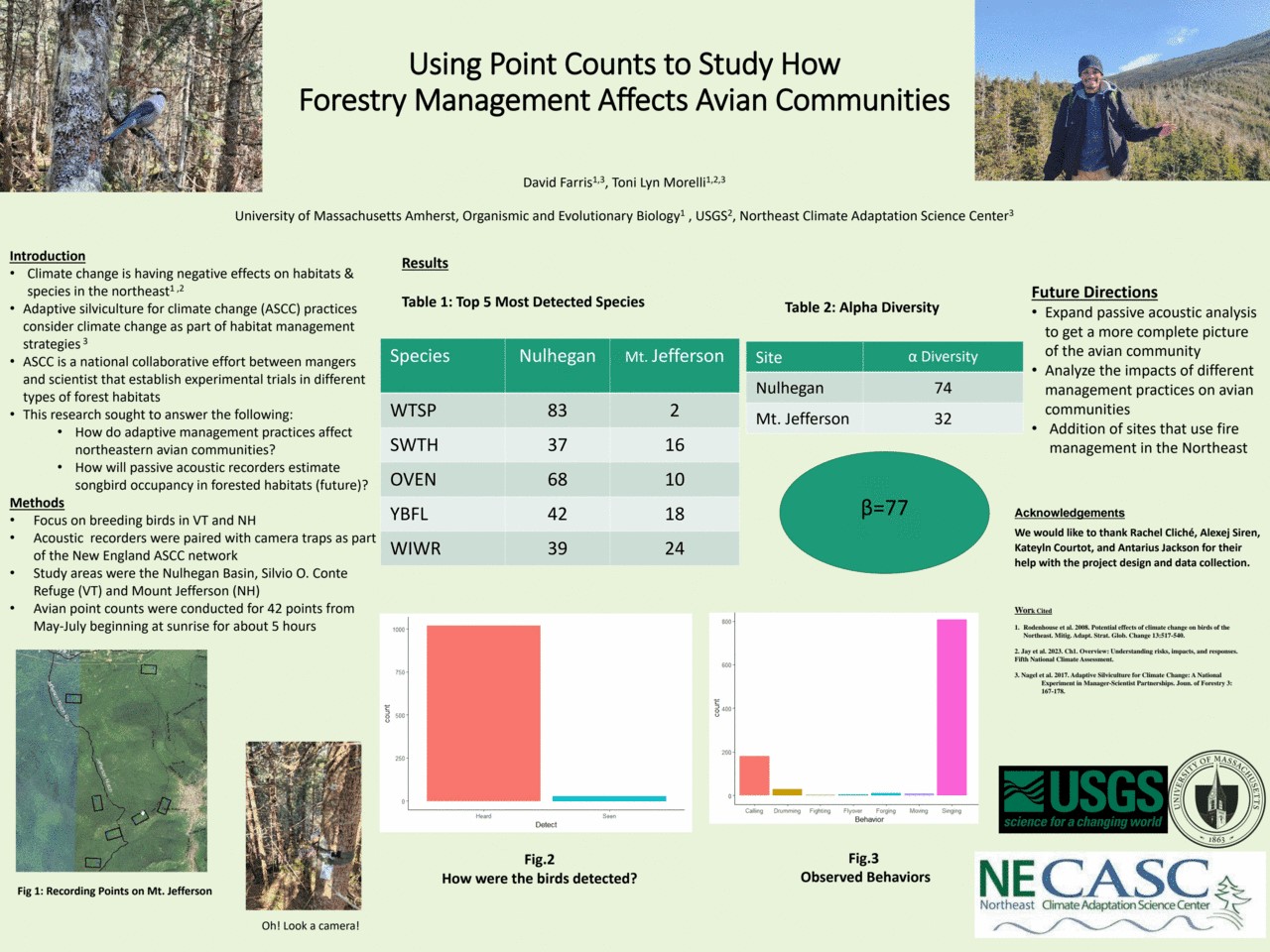
Using Point Counts to Study How Forestry Management Affects Avian Communities
Toni Lyn Morelli, USGS


